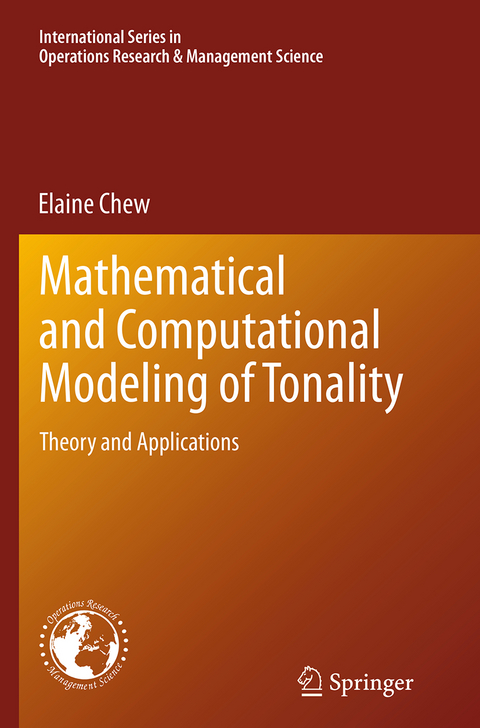
Mathematical and Computational Modeling of Tonality
Theory and Applications
Seiten
2016
|
Softcover reprint of the original 1st ed. 2014
Springer-Verlag New York Inc.
978-1-4899-7929-2 (ISBN)
Springer-Verlag New York Inc.
978-1-4899-7929-2 (ISBN)
Connecting mathematical representations of music to computational problem-solving, the author's spiral array geometric model for tonality benefits from his unique perspective-as concert pianist and successful PhD candidate in operations research.
From the Preface:
Blending ideas from operations research, music psychology, music theory, and cognitive science, this book aims to tell a coherent story of how tonality pervades our experience, and hence our models, of music.
The story is told through the developmental stages of the Spiral Array model for tonality, a geometric model designed to incorporate and represent principles of tonal cognition, thereby lending itself to practical applications of tonal recognition, segmentation, and visualization. Mathematically speaking, the coils that make up the Spiral Array model are in effect helices, a spiral referring to a curve emanating from a central point. The use of “spiral” here is inspired by spiral staircases, intertwined spiral staircases: nested double helices within an outer spiral.
The book serves as a compilation of knowledge about the Spiral Array model and its applications, and is written for a broad audience, ranging from the layperson interested in music, mathematics, and computing to the music scientist-engineer interested in computational approaches to music representation and analysis, from the music-mathematical and computational sciences student interested in learning about tonality from a formal modeling standpoint to the computer musician interested in applying these technologies in interactive composition and performance. Some chapters assume no musical or technical knowledge, and some are more musically or computationally involved.
From the Preface:
Blending ideas from operations research, music psychology, music theory, and cognitive science, this book aims to tell a coherent story of how tonality pervades our experience, and hence our models, of music.
The story is told through the developmental stages of the Spiral Array model for tonality, a geometric model designed to incorporate and represent principles of tonal cognition, thereby lending itself to practical applications of tonal recognition, segmentation, and visualization. Mathematically speaking, the coils that make up the Spiral Array model are in effect helices, a spiral referring to a curve emanating from a central point. The use of “spiral” here is inspired by spiral staircases, intertwined spiral staircases: nested double helices within an outer spiral.
The book serves as a compilation of knowledge about the Spiral Array model and its applications, and is written for a broad audience, ranging from the layperson interested in music, mathematics, and computing to the music scientist-engineer interested in computational approaches to music representation and analysis, from the music-mathematical and computational sciences student interested in learning about tonality from a formal modeling standpoint to the computer musician interested in applying these technologies in interactive composition and performance. Some chapters assume no musical or technical knowledge, and some are more musically or computationally involved.
Tonality.- An Abbreviated Survey.- The Spiral Array.- The CEG Algorithm (Part I).- The CEG Algorithm (Part II): Validation.- Determining Key Boundaries.- Argus Segmentation Method.- Real-Time Pitch Spelling.- MuSA.RT.- Visible Humor.- Sensitivity Analysis.- Model Calibration.- CEG Key Finding: Bach's WTC book I.
| Erscheinungsdatum | 10.09.2016 |
|---|---|
| Reihe/Serie | International Series in Operations Research Management Science ; 204 |
| Zusatzinfo | 46 Illustrations, color; 108 Illustrations, black and white; XIV, 305 p. 154 illus., 46 illus. in color. |
| Verlagsort | New York |
| Sprache | englisch |
| Maße | 155 x 235 mm |
| Themenwelt | Kunst / Musik / Theater ► Musik |
| Geisteswissenschaften ► Psychologie ► Verhaltenstherapie | |
| Mathematik / Informatik ► Mathematik ► Analysis | |
| Wirtschaft ► Allgemeines / Lexika | |
| Wirtschaft ► Betriebswirtschaft / Management ► Unternehmensführung / Management | |
| Schlagworte | cognitive science • Computational Models • Mathematical Programming • Music Information Retrieval • music theory • Operations Research • tonality |
| ISBN-10 | 1-4899-7929-8 / 1489979298 |
| ISBN-13 | 978-1-4899-7929-2 / 9781489979292 |
| Zustand | Neuware |
| Haben Sie eine Frage zum Produkt? |
Mehr entdecken
aus dem Bereich
aus dem Bereich
Verhaltensanalyse - Behandlungsplan - Bericht an den Gutachter
Buch | Softcover (2022)
Kohlhammer (Verlag)
35,00 €
psychodynamisch denken – verhaltenstherapeutisch handeln
Buch | Hardcover (2023)
Schattauer (Verlag)
48,00 €


